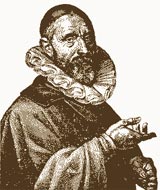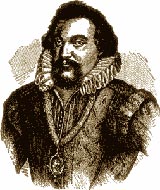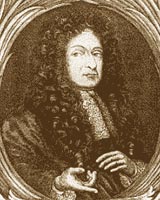|
The beginning of instrumental music, apart
from vocal, is to be found
in the latter part of the sixteenth century, but the main advances
toward freedom of style and spontaneous expression were made during
the seventeenth, and, as we might expect, originally in Italy, where
the art of music was more prosperous, and incitations to advance were
more numerous and diversified. Upon all accounts the honor of the
first place in the account of this part of the development of modern
music is to be given to Andreas Gabrieli (1510-1586), who from a
singing boy in the choir of St. Mark's, under the direction of Adrian
Willaert, succeeded in 1566 to the position of second organist, where
his fame attracted many students.
Among the numberless compositions
emanating from his pen were masses, madrigals, and a considerable
variety of pieces for organ alone, bearing the names of "Canzone,"
"Ricerari," "Concerte," and five-voiced Sonatas,
the latter
printed in 1586, being perhaps the earliest application of this now
celebrated name to instrumental compositions. The pieces of Gabrieli
were mostly imitations of compositions for the voice, fugal in style,
and with never among them a melody fully carried out. Among the pupils
of Andreas Gabrieli were Hans Leo Hassler,
the celebrated Dresden
composer, and Swelinck, the equally celebrated Netherlandish organist.
The beginning of organ composition, and
the higher art of organ
playing, made by Andreas Gabrieli, was carried much farther by his
nephew and pupil, Giovanni Gabrieli (1557-1612), who, born and trained
at Venice, early entered the service of its great cathedral, and in
1585 succeeded Claudio Merulo as first organist of the same. As a
composer Giovanni Gabrieli continued the double-chorus effects which
had been such a feature of the St. Mark's liturgy since the time of
Willaert, but especially he distinguished himself in improving the
style of organ playing, and in giving it a freedom and almost secular
character somewhat surprising for the times. A large number of his
compositions of all sorts are in print, very many "for voices or
instruments." The alternative affords a good idea of the subordinate
position still occupied by instrumental music, but a beginning had
been made, which later was to lead to great things.
 |
 |
| JEAN PIETERS SWELINCK |
SAMUEL SCHEIDT |
The art of organ playing found its next
great exponents in Holland and
Germany, all of them having been pupils of the Venetian master. The
most celebrated of these, considered purely as an organist, was Jean
Pieters Swelinck (1560-1621), who was born at Deventer in Holland, and
died at Amsterdam. He was more celebrated as a performer and
improviser than for the instrumental pieces he published. Among his
pupils was the celebrated Samuel Scheidt (1587-1654), organist at
Halle, who is memorable as the first who made artistic use of the
chorale. Scheidt is also famous as the author of a book upon organ
tabulature, or the notation for organ, which in Germany at this period
was different from that of the piano, and
in fact much resembled the
tabulature for the lute, from which it was derived. It consists of a
combination of lines and signs, by the aid of which the organist was
supposed to be capable of deciphering the intentions of the composer.
No especial importance appears to have been attached to the difference
of notation for instruments and voices in this period. And in fact,
until our own times certain instruments, the viola, for example, have
had their own notation, different from the voices, and different from
that of other instruments. Another celebrated German organist of this
period was Johann Hermann Schein, who, with Scheidt and Swelinck,
constituted the three great German musical S's of the sixteenth
century. Schein (1586-1630) was appointed cantor of the Leipsic St.
Thomas school in 1615, and worked there as
above. His numberless
compositions are more free in style than the average of the century,
and a number of them are distinctly secular. Nevertheless, in the
development of instrumental music he had but small part, not being one
of the highly gifted original geniuses who impress themselves upon
following generations. The great German master of this period was
Schütz, chapel master at Dresden, whose career forms part of the
story of the oratorio, a form of music which he had so large a share
in shaping into its present form.
In order to come once more into the path
of musical empire, we must
return again to Italy, where there was an organist at St. Peter's, who
had in him the elements of greatness and originality. Girolamo
Frescobaldi (1587-1640) was organist of St. Peter's at Rome from
1615. His education had been in part acquired in Italy, and in part in
the Netherlands. As a virtuoso he attained an extraordinary success,
and one of his recitals is reputed to have been attended by as many as
30,000 people. He distinguished himself as composer no less than as
organist, and particularly by his compositions in free style. His
Ricerari, Concertos and Canzones were all protests against the bondage
of instrumental music to the fetters of vocal forms. It was the
compositions of this master, together with those of Froberger, that
Sebastian Bach desired to have, and which, in fact, he stole out of
his brother's book case, and copied in the moonlight nights.
It would take us too far were we to
enumerate all the composers who
distinguished themselves in this century, no one of them succeeding in
composing anything satisfactory to this later generation, but all
contributing something toward the liberation of instrumental music,
and all adding something to its too limited resources. Among these
names were those of Johann Kasper Kerl, organist at St. Stephen's
church in Vienna, who, after having served with distinction at Munich,
returned later and died at Vienna in 1690. Another of these German
masters, also one of those whose compositions Bach wished to study,
was Johann Pachelbel, of Nuremberg (1635-1706). In 1674 he was
assistant organist at Vienna, in 1677 organist at Eisenach, and soon
back to Nuremberg a few years later. His multifarious works for organ,
among which we find a variety of forms, were perhaps the chief model
upon which Sebastian Bach formed his style. He especially excelled in
improvising choral variations, and in fanciful and musicianly
treatment of themes proposed by the hearer. Yet another name of this
epoch, that of George Muffat, is now almost forgotten. He studied in
France, and formed his style upon that of the French. A later master,
also very influential in the style of Sebastian Bach, was Dietrich
Buxtehude (1637-1707). For nearly forty years he was organist at the
Church of St. Mary at Lübeck, where he was so celebrated that the
young Sebastian Bach made a journey on foot there in order to hear and
master the principles of his art. Buxtehude wrote a great number of
pieces in free style for the organ, and, while his works have little
value to modern ears, there is no doubt that this master was an
important influence upon the enfranchisement of instrumental music.
Among all these Netherlandish organists few are better known by name
at the present day than Johann Adam Reinken (1623-1722), who was born
at Deventer, Holland, and after the proper
elementary and finishing
studies, succeeded his master, Scheidemann, as organist at Hamburg.
Here his fame was so great that the young Bach made two journeys there
on foot, in order to hear him. He was a virtuoso of a high order, and
his style exercised considerable influence over that of Bach.

JOHANN
ADAM REINKEN
Meanwhile
the orchestra had been steadily enriched through the
competition of successive operatic composers, each exerting himself to
produce more effect than the preceding. In this way new combinations
of tone color were contrived, and now and then introduced in a fortunate manner, and effects of greater
sonority were attained
through the greater number of instruments, and the more expert use of
those they had.
|







